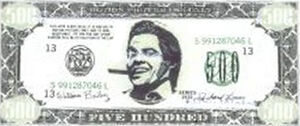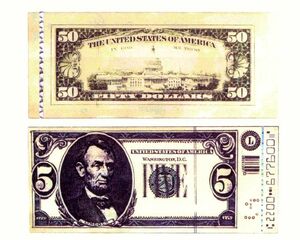
A Biff Bill, Biff Tannen's own form of currency, from 1985A. Spend it wisely.
- "I have to be prepared for all monetary possibilities."
- —Emmett Brown to Marty McFly
Money was seen and used extensively throughout Marty McFly's travels through time.
Money in the 20th century
While in 1955, Marty paid for some coffee at Lou's Cafe, though Lou didn't seem to notice the date on the coins.[1]
After having arrived on November 12, 1955, Doc pulled out his money suitcase which contained assorted stacks of currency from different time periods (all clearly labeled); these included 1861, 1863, 1875, 1914, and 1917.[2]
On October 25, 1985, Marty gave a quarter to the Hill Valley Preservation Society to help preserve the Courthouse.
Biff Tannen had his own form of currency in 1985A, the Biff Bill (also sometimes referred to as a "Biff Buck"[3]), featuring his portrait where a US President's would go normally. Also, the huge neon illustration of Biff at the entrance to Biff Tannen's Pleasure Paradise Casino & Hotel depicted him lighting a cigar with a burning $100 bill.[2]
On May 14, 1986, Biff used a quarter on Doc's jukebox to hear Back in Time.
Money in 2015

Dollar bills from 2015, with security threads and barcodes.
- "But there was something different about this version of 'Wild Gunman'. For one thing, Marty couldn't find the coin slot. / 'Where do you put in the quarter?' he asked. / 'Quarter?' the kid replied. 'What's a quarter?' "
- —From Back to the Future Part II by Craig Shaw Gardner (quote, page 36)
In 2015, dollar bills had security threads and barcodes, but by this time cash was rarely used as thumbprints had become an alternate form of currency; most transactions being automatic and signed on a thumb pad. Cash was used so infrequently that businesses had a handling surcharge for paying in cash.[4] Quarters and other change appeared to be obsolete as machines, such as the Wild Gunman in the Cafe 80's, had no coin slot — and two kids Marty spoke to didn't even know what a quarter was.[4]
As 2015 money did not have the marking of "Federal Reserve Note", it was strongly suggested that central banking was abolished in the United States by 2015.
Inflation in 2015 meant that products that would normally sell for around one dollar in 1985 now cost around $45, such as a bottle of Pepsi Perfect.[4]
The menu at Cafe 80's had the pricing style of placing the dollar sign after the amount rather than before — e.g. 7$ instead of the more familiar $7.
While in 2015, Marty purchased Grays Sports Almanac from the Blast from the Past antique/memorabilia store by selling his pocket change and dollar bills as antique currency.[4]
Behind the scenes
- Images of 2015 currency appear not too radically different from bills that have since been released in the United States in the 2000s, where the portrait of the President is offset or the individual is removed from the portrait. There is also the inclusion of security threads and other features.
- If there ever was an idea that Lou noticed the date on money handed to him, let alone "attempted to have Marty arrested for passing counterfeit money", it was not in the first [1] nor fourth [2] draft of the screenplay. Scenes were written in both versions, as well as the novelization, showing Marty attempting to pay with a $20 bill and being told "What do you think this is, a bank?" (in 2012, this would be similar to paying for coffee with a $100 bill), but not included in the film itself. A subplot about Lou suspecting Marty of passing counterfeit money would not only have distracted from the film, but would also have been inconsistent with Marty's subsequent visits to Lou's Cafe.
- In Back to the Future Part II, Marty did not throw a coin, or anything else, into the stairwell to cause a distraction while running down the hotel stairs to escape Biff's gang. Moving more quickly, he hopped the railing to get to another staircase, running upward toward the roof, while the gang continued downward. However, in the novelization by Craig Shaw Gardner, which was adapted from an earlier script, Marty did toss a quarter down the stairway to confuse Biff's gang. (page 185)
- In the novelization by Craig Shaw Gardner, an explanation is given as to how Marty purchased Gray's Sports Almanac. Next to the almanac in the window, Marty sees a sign that says WE BUY ANTIQUE BILLS AND COINS and reasons to himself, "So he could even pay for it from his own wallet. It was perfect!" (quote, page 60), implying that he then sold his 30+ year-old coins and bills for more than their face value. As a used reference book already 15 years out of date in 2015 (and had pages made of inferior paper that did not repel dust), the almanac itself would probably not be as expensive as the antiques. Neither the novelization, nor the film, show Marty actually selling his "antique" money. The film shows that the store window has the words ANTIQUE COINS in large letters on the outside; in editing, the scene shifts from Marty talking with Terry, to Marty receiving the already-purchased book from the saleswoman.
- The novelization also changes the method by which Emmett Brown accesses his money for time travel. Rather than a suitcase as seen in Part II, Doc has a money belt, with currency from 1882, 1921, 1955, 1985, and 2015, plus gold, silver, and doubloons.
Actuality (2015)
- A new $100 bill was put into circulation on October 8, 2013, which features a blue security thread with a moving illusion.
- The inflation predictions (shown by the prices on the Cafe 80's menu) have not come to pass. As of 2015, the price of a bottle of Pepsi in a restaurant in California would be a little less than $2.
- The style of quoting the prices (7$ rather than $7 on the menu) hasn't been adopted in real life.
